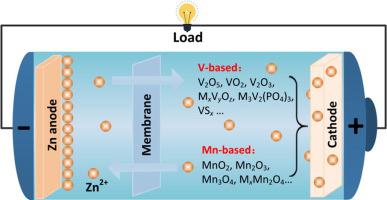Journal of Energy Chemistry ( IF 14.0 ) Pub Date : 2020-11-06 , DOI: 10.1016/j.jechem.2020.10.044 Na Liu , Bin Li , Zhangxing He , Lei Dai , Haiyan Wang , Ling Wang

|
The growing demand for energy storage has inspired researchers’ exploration of advanced batteries. Aqueous zinc ion batteries (ZIBs) are promising secondary chemical battery system that can be selected and pursued. Rechargeable ZIBs possess merits of high security, low cost, environmental friendliness, and competitive performance, and they are received a lot of attention. However, the development of suitable zinc ion intercalation-type cathode materials is still a big challenge, resulting in failing to meet the commercial needs of ZIBs. Both vanadium-based and manganese-based compounds are representative of the most advanced and most widely used rechargeable ZIBs electrodes. The valence state of vanadium is +2 ~ +5, which can realize multi-electron transfer in the redox reaction and has a high specific capacity. Most of the manganese-based compounds have tunnel structure or three-dimensional space frame, with enough space to accommodate zinc ions. In order to understand the energy storage mechanism and electrochemical performance of these two materials, a specialized review focusing on state-of-the-art developments is needed. This review offers access for researchers to keep abreast of the research progress of cathode materials for ZIBs. The latest advanced researches in vanadium-based and manganese-based cathode materials applied in aqueous ZIBs are highlighted. This article will provide useful guidance for future studies on cathode materials and aqueous ZIBs.
中文翻译:

用于水性锌离子电池的钒和锰基正极材料的最新进展和观点
对能量存储的需求不断增长激发了研究人员对先进电池的探索。水性锌离子电池(ZIBs)是可以选择和追求的有前途的二次化学电池系统。充电式ZIB具有安全性高,成本低,环保,竞争优势等优点,受到了广泛的关注。然而,合适的锌离子嵌入型阴极材料的开发仍然是很大的挑战,导致不能满足ZIBs的商业需求。钒基和锰基化合物都是最先进和使用最广泛的可充电ZIBs电极的代表。钒的价态为+2〜+5,可以实现氧化还原反应中的多电子转移,具有较高的比容量。大多数锰基化合物具有隧道结构或三维空间框架,并具有足够的空间来容纳锌离子。为了了解这两种材料的储能机理和电化学性能,需要对最新技术进行专门审查。这项综述为研究人员提供了了解ZIB正极材料研究进展的途径。重点介绍了应用于水性ZIBs的钒基和锰基正极材料的最新先进研究。本文将为以后对正极材料和水性ZIBs的研究提供有用的指导。为了了解这两种材料的储能机理和电化学性能,需要对最新技术进行专门审查。这项综述为研究人员提供了了解ZIB正极材料研究进展的途径。重点介绍了应用于水性ZIBs的钒基和锰基正极材料的最新先进研究。本文将为以后对正极材料和水性ZIBs的研究提供有用的指导。为了了解这两种材料的储能机理和电化学性能,需要对最新技术进行专门审查。这项综述为研究人员提供了了解ZIB正极材料研究进展的途径。重点介绍了应用于水性ZIBs的钒基和锰基正极材料的最新先进研究。本文将为以后对正极材料和水性ZIBs的研究提供有用的指导。





















































 京公网安备 11010802027423号
京公网安备 11010802027423号